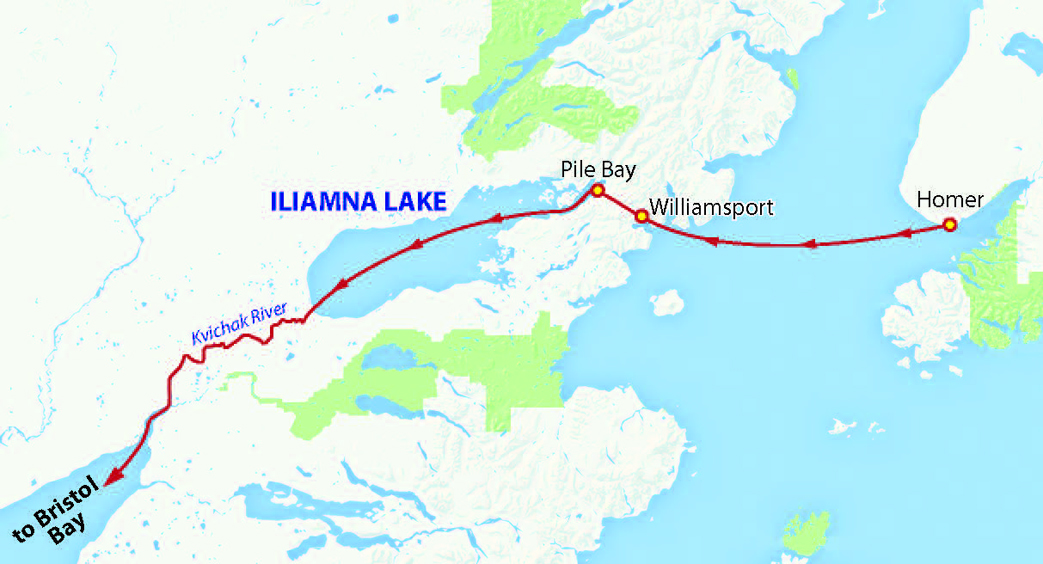PILE BAY — It’s noon. Iliamna Lake is calm and half a dozen fishermen are sitting around in the grass outside the bathroom at Pile Bay using free wi-fi.
A soon-to-be setnetter makes a Facebook page for another fisherman. His brother (and this reporter) pitch in with photos and suggestions for friends. The three of us are riding to Naknek with Louie Flora and his daughter Sidney onboard the F/V Eagle Claw.
“Did you know they’re making me a Facebook account?” Louie Flora asks Sidney, who’s traveling to Bristol Bay with him for her first fishing season.
He doesn’t sound entirely excited about this. Sidney is more enthusiastic.
“Cool,” she says, making sure that devices are charging in all four outlets in the bathroom so that there’s ample entertainment for the next leg of the trip to Bristol Bay.
The new Facebook page probably won’t get much use in the next month or so, and time for lying around in the grass will be limited.
The Alaska Department of Fish and Game is forecasting that more than 50 million sockeye salmon will return to Bristol Bay this summer, and eventually these fishermen’s clocks will be set to the openers in each of five fishing districts.
But before they start fishing, about 60 boats make the trip from Kamishak Bay to Bristol Bay via the Williamsport Road and the Kvichak River.
The Williamsport Road links Iliamna Bay, across Cook Inlet west of Homer, to the northeast side of Iliamna Lake at Pile Bay. Then boats travel 70-some miles across the lake to the Kvichak River and on down the braided Kvichak River to its outlet at the northeast end of Bristol Bay. Most boats then go on to Naknek, a home base for fishing boats on the east side of Bristol Bay.
That’s a much shorter route than the 1,000 miles through the Gulf of Alaska and around the Alaska Peninsula.
Ray Williams and his son Chet haul the boats over the 15-mile Williamsport Road, four boats per tide, one or two tides per day, from early June until everyone gets across. In July, they start hauling them back the other way when the boats are done fishing.
Ray also provides the bathroom — complete with towels for the shower — and the wi-fi, which comes from a router hooked up to a parked truck nearby.
The Williams family has been here for 77 years, since Ray’s dad moved from New York to Alaska for his health; he was so nervous around thunderstorms that he couldn’t eat (his dad had been killed by lightning) and he was 120 pounds when he moved north. Within a couple years, he was 250 pounds and eventually he hauled mail for area villages on his back.
The Williams family no longer hauls mail, but they still haul boats — and just about anything else that needs to be delivered to communities on the lake — with trucks, loaders and, for the lake, a barge.
Last year, they hauled a record 120 boats, 60 each way, and Ray said they’re on track for that many again this year.
Bristol Bay gillnetters are limited to 16 feet wide, but the road can only really handle 14 feet, and Ray said some boats are built to just that size to make the trip. Many of the boats that make the trip come back year after year, he said, and he knows how they fit on his custom-built trailers — including the Eagle Claw and the Independence, Brent Cathey’s boat.
Flora and Cathey, another Homer fisherman, are waiting on a third Homer boat, the Solstice, before they set out from Pile Bay, where they put their boats back into the water late on June 14.
The trio left Homer on June 13, and arrived near Williamsport that evening. It took about 10 hours for the Eagle Claw to make it approximately 80 miles. That was enough time for a small kitchen fire to alert us that the propane stove was out of commission, everyone onboard to take turns napping, plenty of oohing and aahing at Mt. Augustine and other peaks, and for a lot of jellybean eating.
Our caravan isn’t the only group waiting at Pile Bay. Three other gillnetters, all with crews from the Kenai Peninsula, are waiting for another boat or two to come across the road and join them. They’re mostly Old Believers and don’t travel on Sundays for religious reasons, so they got stuck on different sides of the road Saturday and are waiting to regroup before taking off.
A couple of other Russians’ boats have already left. One left shortly after midnight June 15, and some the next morning after they got hauled over the road.
Cathey and Flora have made the journey before, as have most of their crew — everyone but Sidney and I. They know that once they get past Igiugig, at the other end of Iliamna Lake, the braided channels can be difficult to navigate, and it’s easier with a guide and friends to help pull if necessary.
They also know how to pass time: Waiting near Williamsport, we went swimming and hiking and canoeing, and fiddled with boat stuff. Here in Pile Bay, we’re watching the friend count on Louie’s page tick up, canoeing, working, doing more boat fiddling, contemplating a swim — and hoping that we’re not missing out on any fish.
I check the Alaska Department of Fish and Game blue sheet estimate, and only a couple thousand fish have been landed in Bristol Bay by mid-day on June 15, so no one is too worried about the fishery taking off without us.
Good.
That means it’s time to go canoeing.
Molly Dischner is the fisheries reporter at KDLG in Dillingham. She’s making the trip from Kachemak Bay to Bristol Bay onboard the F/V Eagle Claw.


